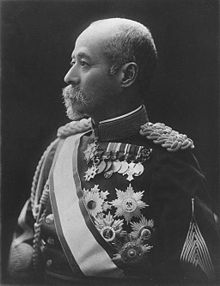Kodama Gentaro
Shishaku Kodama Gentarō ( Japanese 兒 玉 源 太郎 ; born March 16, 1852 in Tokuyama , Suō Province , Japan ; † July 23, 1906 in Tokyo ) was a general in the Imperial Japanese Army and a politician during the Meiji period . He was instrumental in building a modern army after the end of the Tokugawa shogunate .
Life
Kodama was born in Tokuyama, Suō Province, part of what is now Yamaguchi Prefecture , in 1852 into a Samurai family of Chōshū-han . He gained his first combat experience when he fought against the Tokugawa shogunate on the side of the troops loyal to the emperor for the Meiji restoration in the Boshin War . As part of the young Japanese army, he took part in the suppression of the Satsuma rebellion . He later completed an officer training course at Osaka Heigakuryo ( 大阪 兵 学 寮 ), which he completed in 1881.
After graduating, he was appointed commander of the Army University , where he worked together with the German major Jakob Meckel on the reorganization of the Japanese army based on the Prussian model . He was later sent to the German Reich to study military science as a military attaché . After his return in 1892 he served as Deputy Minister of the Army .
After participating in the First Sino-Japanese War , he became the Japanese Governor General of Taiwan in February 1898 . During his tenure, he worked hard to improve the island's infrastructure and the living conditions of the residents. Due to his good performance, he was appointed Minister of the Army under Prime Minister Itō Hirobumi in December 1900 , which he remained until March 1902. In July 1903, the following Prime Minister Katsura Taro appointed him education and Minister of Internal Affairs , which he stayed until September and October of the same year.
The following year, Kodama's promotion to full general took place. Nevertheless, after the outbreak of the Russo-Japanese War he was asked by Gensui Ōyama Iwao whether he could serve as Chief of Staff of the troops in Manchuria , which meant a step backwards in terms of rank. Kodama accepted the offer and worked out with his staff the strategic plans for all subsequent land operations of the war, which earned him a lot of public sympathy. It was similar to General Kawakami Sōroku , who served as chief of staff ten years earlier in the Sino-Japanese War . After the war he was given the post of Chief of the General Staff of the Japanese Army in April 1906 , but died just three months later.
Kodama had quickly risen to the ranks of Danshaku and Shishaku in the Japanese nobility system of Kazoku , and his death from intracerebral haemorrhage was considered a national disaster. After his death, the Tennō Meiji awarded him posthumously with the first order of the Golden Consecration, 1st class. He was later raised to the rank of Shinto Kami , and shrines of honor are still erected in his hometown Shunan and at his summer estate in Enoshima .
literature
- Richard Connaughton: Rising Sun and Tumbling Bear. Cassell, 2003, ISBN 0-304-36657-9 .
- Leo TS Ching: Becoming Japanese. Colonial Taiwan and the Politics of Identity Formation. University of California Press, Berkeley 2001, ISBN 0-520-22553-8 .
- Trevor N. Dupuy : Encyclopedia of Military Biography. IB Tauris & Co, 1992, ISBN 1-85043-569-3 .
- Kowner, Rotem (2006). Historical Dictionary of the Russo-Japanese War. Scarecrow, ISBN 0-8108-4927-5 .
- Meirion Harries: Soldiers of the Sun. The Rise and Fall of the Imperial Japanese Army. Random House, 1994, ISBN 0-679-75303-6 .
- Gorō Mutsu: Kodama Gentarō. In: Kodansha Encyclopedia of Japan. Kodansha, 1985.
Web links
- National Parliamentary Library : Brief biography of Kodama on the Japanese Parliamentary Library website. (Engl.) Accessed on June 12, 2012.
Individual evidence
- ^ A b Trevor Nevitt Dupuy: Encyclopedia of Military Biography. 1992.
- ↑ Meirion Harries: Soldiers of the Sun. The Rise and Fall of the Imperial Japanese Army. 1994.
- ↑ Leo TS Ching: Becoming Japanese. Colonial Taiwan and the Politics of Identity Formation. 2001.
- ^ Richard Connaughton: Rising Sun and Tumbling Bear. 2003.
| personal data | |
|---|---|
| SURNAME | Kodama, Gentaro |
| ALTERNATIVE NAMES | 兒 玉 源 太郎 (Japanese) |
| BRIEF DESCRIPTION | Japanese general and politician |
| DATE OF BIRTH | March 16, 1852 |
| PLACE OF BIRTH | Tokuyama , Suō Province , Japan |
| DATE OF DEATH | July 23, 1906 |
| Place of death | Tokyo , Japan |
